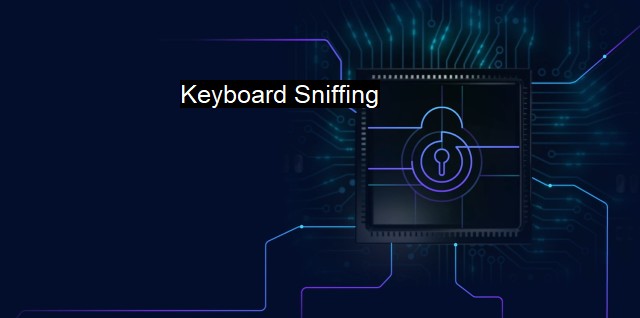What is Keyboard Sniffing?
Understand Keyboard Sniffing: How Black Hat Hackers Can Steal Your Data and Attack Your Privacy.
Keyboard sniffing refers to the techniques used by nefarious cyber actors to monitor and capture the keystrokes on a user's keyboard. The primary objective of keyboard sniffing is to illegitimately collect data directly from users, such as personal details, debit and credit card information, login credentials (passwords, usernames), and other sensitive details, to further perform malicious activities. These activities often include but are not limited to committing fraud, stealing identities, manipulating data, launching damaging softwares, or selling the acquired data on the dark web. This type of illicit data collection method poses significant security threats, potentially jeopardizing data integrity, privacy, and organisational assets.Keyboard sniffing is an umbrella term that spans across several tactics such as keylogging, hardware device modification, wireless sniffing, acoustic cryptanalysis, electromagnetic sniffing, and more recently smartphone keyboard sniffing, ensuring the malicious attack vectors can exploit every form of digital communication and rendering conventional cybersecurity suites inefficient.
Keylogging, be it software or hardware, is one of the most recognized and prevalent forms of keyboard sniffing. A malicious software, also known as a keylogger, can be installed unknowingly when users open suspicious emails, download harmful software, or visit malware-infected websites. Similarly, a physical keylogger might be discreetly connected in between one's keyboard and computer, storing all the keystrokes recorded. it isn't always easy to detect them, as they run silently in the background and are often integrated into trojans or rootkits that largely evade detections from antiviral and antispyware softwares.
Wireless sniffing purloins the data transmitted over a wireless network. Given most keyboards have transitioned to the wireless platform, cybercriminals can intercept these radio frequencies or Bluetooth signals to steal information. Acoustic cryptanalysis, on the other hand, interprets the unique sound produced by each key on a keyboard and deciphers the keystrokes.
Electromagnetic sniffing employs similar philosophy to acoustic cryptanalysis by discerning the electromagnetic emanations associated with different keys. Smartphone keyboard sniffing is a recent, rapidly advancing field where cyber attackers create a unique thermal footprint of every key by correlating it to the touch sensor's location to interpret what specifically was typed—a form of eavesdropping technique.
Understanding the keyboard sniffing techniques, cybersecurity experts equip various methods to deftly tackle this issue. This includes promoting best practices such as using on-screen or virtual keyboards, automatic form-filling softwares, biometric authentication, strong firewall settings, regular updates, and reliable antiviral software.
Encryption is another successful antidote to these sniffing maneuvers as it codes information when transmitted over a wireless network, rendering intercepted data useless. Other advanced measures may encompass the use of specialised tools such as keystroke-dynamics biometrics that study the unique typing rhythm and speed of a user, thus adding another layer of authentication.
Despite these intensified security measures and user caution, keyboard sniffing constitutes a significant menace to individual, corporate, and even national cybersecurity. Hence, it is indispensable for individuals and corporates to continuously update and improve their security policies and antivirus programs while advancing in digital literacy and awareness of these surreptitious cyber threats. Understanding and acknowledging keyboard sniffing as a serious threat will go a long way in creating a safer digital landscape.
A resilient cybersecurity setup coupled with a discerning digital habitat, encompassing frequent antivirus updates, appropriate encryption, robust network securities, stringent authorization regulation, and most importantly, a wary user behaviour when handling suspicious emails or websites, will form the frontline against keyboard sniffing and contribute significantly towards a secure cyber ecosystem.

Keyboard Sniffing FAQs
What is keyboard sniffing?
Keyboard sniffing is the process of capturing keystrokes on a computer system, usually without the user's knowledge or consent. The captured keystrokes can be used to steal sensitive information, such as passwords, credit card numbers, and other personal data.How is keyboard sniffing performed?
Keyboard sniffing can be performed through software or hardware-based methods. Software-based keyboard sniffers are typically installed on a target computer and run in the background, capturing and logging all keystrokes. Hardware-based keyboard sniffers are physical devices that are connected between a keyboard and a computer, intercepting and recording all keystrokes.How can I protect myself from keyboard sniffing?
To protect yourself from keyboard sniffing, you can use antivirus software that detects and removes keyloggers and other malicious software. You can also use a virtual keyboard, which allows you to input text by clicking on an on-screen keyboard rather than typing on a physical keyboard. It is also important to practice good cybersecurity habits, such as using strong and unique passwords, avoiding suspicious websites, and keeping your software up-to-date.Is keyboard sniffing illegal?
In most cases, keyboard sniffing is illegal when it is performed without the user's knowledge or consent. It is considered a privacy violation and can result in criminal charges. However, there may be exceptions where keyboard sniffing is legal, such as in cases where law enforcement agencies use it as part of an investigation with a warrant.| | A | | | B | | | C | | | D | | | E | | | F | | | G | | | H | | | I | | | J | | | K | | | L | | | M | |
| | N | | | O | | | P | | | Q | | | R | | | S | | | T | | | U | | | V | | | W | | | X | | | Y | | | Z | |
| | 1 | | | 2 | | | 3 | | | 4 | | | 7 | | | 8 | | |||||||